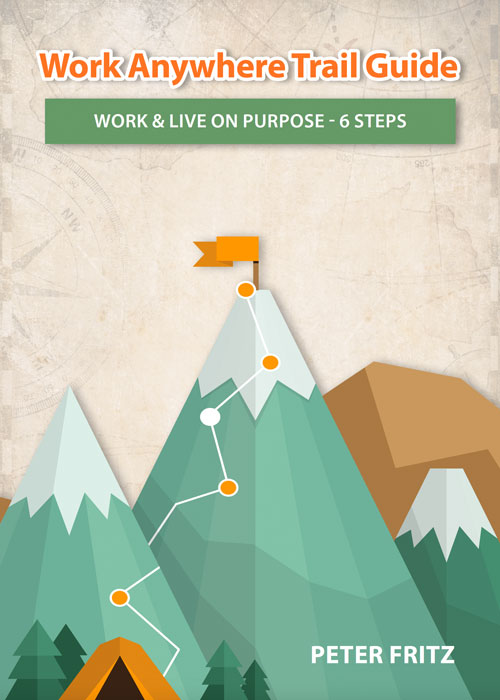[smart_track_player url=”http://traffic.libsyn.com/midlifetribe/How_to_convince_your_boss_to_let_you_work_remotely_-_087.mp3″ background=”#f2f2f2″ social_gplus=”false” social_linkedin=”true” social_email=”true” ]
Millions of professionals around the world work remotely – from home offices, cafes, coworker spaces and lakeside cabins. Some criss-cross the globe in clapped out Combi Vans, stopping at exciting destinations to knock out their work along the way. Others like to stay in one spot, like my friend Laura, who runs a substantial operation from her designer couch in swanky New York City. Over the last 20 years, I’ve worked from dozens of different locations, and I swear to everything that’s holy I’ll never go back to an office in the city; not even for triple the money.
I often describe remote work as ‘the gateway drug to freedom and happiness’ because it delivers so many benefits – none of which exist in a cubicle in the city. It’s also the best way to segway into your own business because of the time it saves (no more commuting) and the flexibility it offers around working hours.
For some of you, though, it remains a dream. That’s because you’re scared to ask your boss about it.
I want to help you get past that fear with a simple plan of attack. By the end of this post, and armed with the free download mentioned at the end, you’ll be more confident and better equipped to convince your boss to let you work remotely.
Workplace Culture is Changing
We’re in the midst of a global paradigm shift, where millions of jobs can now be done from anywhere in the world using a laptop and an Internet connection. Collaboration, project tracking and production can all be managed online, effectively freeing many workers from their concrete towers. It’s getting more common by the day, but some of us still don’t see it as mainstream.
And that’s the problem. Some of us fear the jump because, like any big cultural change, we want to see more evidence first. We want the shift to become the new default before we can feel safe enough to join in.
The citizens of Manhattan did this with electricity. In fact, the Edison Electric Illuminating Company of New York was created in 1882, but most Americans lit their homes with gas lights and candles for another fifty years. In fact, more than 40 years later, only half of New York was lit by electricity.
Most of us did the same thing in the ’80s when the IBM PC was launched (granted, it was stupidly expensive then). Despite my fascination with computers, I didn’t get my first one until 1995, yet it still cost $6,500 and only had a 1.2 Gb hard drive. My phone has 256.
Speaking of phones, I railed against touchscreens for years after the iPhone was launched, clutching my beautiful Nokia E71 until the much more beautiful iPhone 4S finally won me over.
Today, we all use light switches, most of us have computers, and everyone’s phone (except my 76-year-old mum’s) has a touchscreen.
So, we resist change even when it’s good for us. But let’s assume you’re already sold on the benefits of working remotely. Why are you scared to broach the topic?
My boss will assume I’m not dedicated.
You think your boss will picture you slouched in front of the TV watching Netflix and eating ice cream. She’ll think you’ve lost interest in your work and want to slack off full-time instead of covertly at the office. Maybe she’ll assume you’re working for the competition on the side.
Okay, chances are none of this is true – not if you’ve proven yourself to be a productive and valued member of the team. If you’re already flaking off at work, then it’s a different story – you’ll need to up your game before tackling this idea.
No, pitching your boss to let you work remotely all comes down to five important elements, which we’ll touch on in a minute.
I’ll be passed over for promotions.
First off, is that what you value most? Really, think about it for a minute. And it may not even be true. Some of today’s most successful companies are run by an entirely distributed workforce – often globally. They have no corporate HQ; no offices, no water cooler in the hall.
Secondly, I’d suggest you think about the ultimate motivation behind the outcomes you seek. Is getting that VP or C-level title what you really want? Is it the money, the respect, the acknowledgement for a job well done?
What if you could make even more money working remotely? What if you could see your children and your partner more? What if your stress levels plummetted and you enjoyed life more than you ever thought possible?
If moving through the corporate machine still matters to you, then make it known when you begin this undertaking. You might have to choose one or the other.
People won’t take me seriously.
Thirty years ago, the whole work-from-home thing had a folksy vibe to it. It smelled like stale bedclothes, Hobbytex and toast. It was something craftspeople did. Twenty years ago, it was something the 0.03% of network marketing people who made money did. Ten years ago, it was eBayers, Amazon sellers and other laptop lifestyle proponents. Today, it’s all the same people (my wife’s run a successful eBay business from home for almost eight years), but now it’s full of professionals, too.
People like you and me: techies, designers, creatives, consultants, advisors, team leaders and business owners.
Today, thanks to the Internet and a growing catalogue of powerful apps, it’s possible (and increasingly common) to run multi-million-dollar businesses from a home office. I know people personally who own and run high-six, seven and eight-figure businesses from their homes. Likewise, each week sees thousands of professionals and executive-level employees run their teams from remote locations.
So if you’re worried people won’t take you seriously, you’re worried about the wrong people.
I won’t make as much money.
Not to throw cold water on this because who doesn’t love money, right? But as you know, money ain’t everything. It solves a lot of problems where money works, but there are many parts of your life where money makes little difference – like work/life balance, autonomy and time with those you care about.
If you pursue a side hustle (when you work from home, it’s much easier to find the time), you might actually make a lot more than you could in your job – and with none of the arse-kissing, either. My aforementioned pal (Laura) earns up to $10,000 a day for her epic copywriting chops.
The 5 Elements of a Good Work-From-Home Pitch
Okay, now to the meat. Your goal here is to gain trust, flexibility and autonomy in your work – thus allowing you to work on your terms. Once you have that, things take on a fresh new lustre, and you’re able to start creating the life you want.
To pull it off, though, you’ll need to tick a few boxes first.
1. Get clear on the objectives.
Outline in writing why you want to do this and sprinkle everything with a good dusting of benefits to your employer. Here are some examples:
Working from my home office delivers:
- Fewer distractions, which means more deep work – better bang for their buck
- More available productive time (thanks to no commuting)
- Better mental health and lower stress levels
- Lower costs (it frees up a cubicle, desk, car space, massage therapist – whatever your boss provides)
- A more respectful relationship with the company (thanks to their trust in your output vs attendance)
- Closer connection to family – meaning a happier, more engaged employee
2. Gather evidence to support your case.
If you’re planning a holiday, chances are within two weeks you’ll know more about your destination (right down to the colour of the pool towels) than 99.999% of your friends. Don’t assume your boss knows as much about remote work as you.
Your job is to educate them – not with a lecture, but with evidence. Do your homework. Google case studies on businesses who’ve switched to remote working arrangements. Send them here, to this website if you like.
Here are some other great resources you can direct them to:
- INC – Why Remote Work is Nothing to Fear
- FORBES – At these 125 Companies, all or Most Employees Work Remotely
- 40+ Companies Share Their Secrets To Remote Work Success
- For a comprehensive list of statistics related to remote work, go to this report summary at Global Workplace Analytics. It’s powerful.
Highlight key technologies that empower remote workers and mention tools your company already uses that would facilitate this.
3. Give them the necessary assurances.
Here’s what employers care about most with their employees – that they are:
- Accountable
- Reachable
- Productive.
When you work remotely, you need to make sure you over-deliver on all three of these.
Be utterly transparent with your work. Don’t ever lie and don’t exaggerate. Sometimes I work in my car, a local nature park or a cosy restaurant up in the mountains. If a colleague calls when I’m there, I tell them about it.
Some of my best work has happened at a picnic table overlooking the Yan Yean Reservoir. And my best ideas come to me when I’m blasting up a mountain road with the roof peeled back. Or in the shower at midday.
Bottom line – deliver on your promises and track progress in a place when your boss can keep tabs. Always be reachable; more so than your cubicle-bound colleagues. And deliver everything on time, with a little something extra to sweeten the experience.
4. Show them how you’ll work.
List all the tools you’ll use to ensure you’re accountable, reachable and productive. Some of the tools I’ve used include:
- Slack
- Basecamp
- Skype
- Goto Meeting
- Zoom
- Loom
- Screen Cast-O-Matic
- Harvest
- Text and email (obviously)
Also, propose a set of metrics that define the success or failure of this arrangement. Focus on the things that matter most to your employer (based on their likely objections) and hone in on those.
Provide a suggested course of action should a failure point be breached. It could involve a different tool, a different time-frame or a different time of day. Account for possible setbacks and be ready with a course-correction if needed.
Be specific with your claims. E.g. “I’ll get more of X done per day/week, I’ll have X ready before X-o’clock, there will be no drop in productivity, and I won’t be any less reachable.
Identify all the tasks you perform in your role and outline how and when they’ll be executed in a remote situation. Perhaps, because you’ll no longer commute, you’ll be able to deliver a regular task earlier than usual – like a weekly report.
If possible, record a short video with your phone showing where you’ll work and why it will improve your productivity and your commitment to the business.
5. Draft a letter requesting a trial.
This is where it all comes together. Craft your proposal as a compelling offer – much like you would to a client/prospect. The purpose of this letter is three-fold:
- It shows you’re taking this seriously.
- It demonstrates respect for their concerns.
- It formalises an undertaking and paves the way for an on-going arrangement should it be successful.
Understand that working remotely isn’t as unusual as you might think. Fifty years ago, change happened slowly. Today, the ratchets of social media, blogs and podcasts – all thanks to the Internet – are making change happen a lot faster.
If you dream of escaping the cubicle, there’s never been a better time. Do it today – I guarantee your life will thank you.
[ss_click_to_tweet tweet=”Many of us want to work remotely, but like any big cultural change, we want to see more evidence first. We want the shift to become the new default before we can feel safe enough to join in.” content=”Many of us want to work remotely, but like any big cultural change, we want to see more evidence first. We want the shift to become the new default before we can feel safe enough to join in.” style=”5″ link=”1″ via=”1″]
The Ultimate Goal – A Dedication to Jon James
Yesterday, a giant in my life called up to offer his final farewell. Today, he married his true love, Aurelia, before entering palliative care. He’s only 64, he’s athletic, and he's stronger than most 30-year-olds. But when cancer takes hold, it doesn’t care. Jonathon...
What are the first steps to starting a side business that makes you money?
[fusebox_track_player url="https://www.buzzsprout.com/1079927/5461972-what-are-the-first-steps-to-starting-a-side-business-ep-115.mp3?blob_id=22247092&download=true" title="What are the first steps to starting a side-business? - EP 115" social_linkedin="true"...
The purpose of purpose
[fusebox_track_player url="https://www.buzzsprout.com/1079927/5195959-the-purpose-of-purpose-ep-114.mp3?blob_id=20946406&download=true" title="The Purpose of Purpose - EP 114" social_linkedin="true" social_email="true" ]Recorded with SquadCastSubscribe: iTunes |...
Download the Guide





